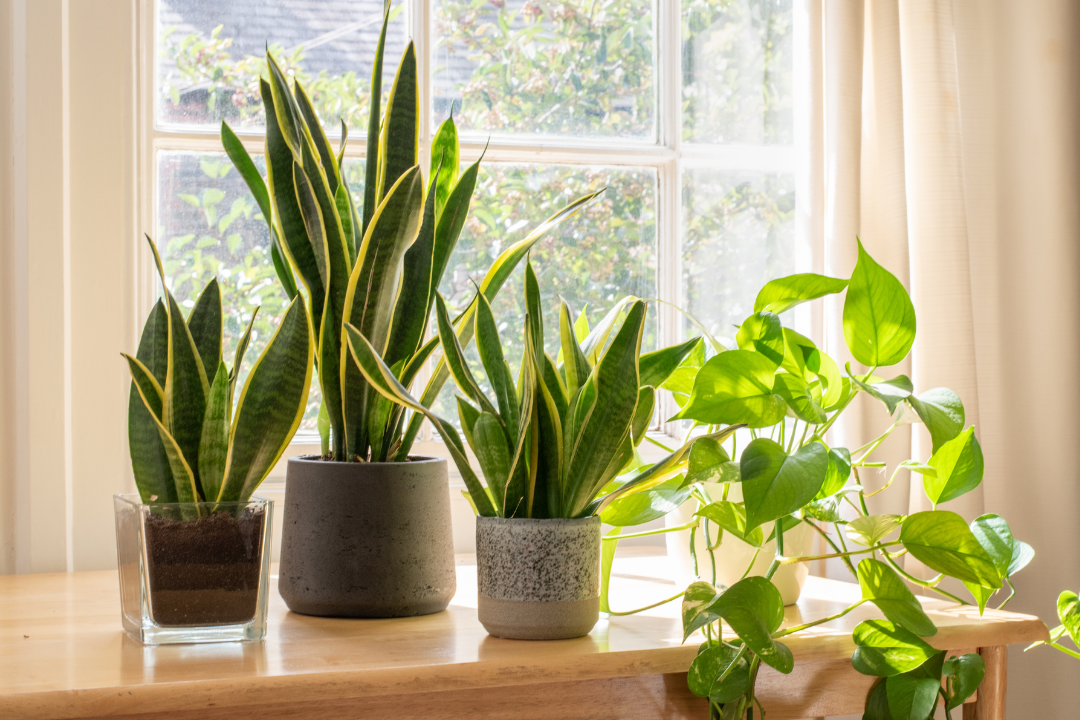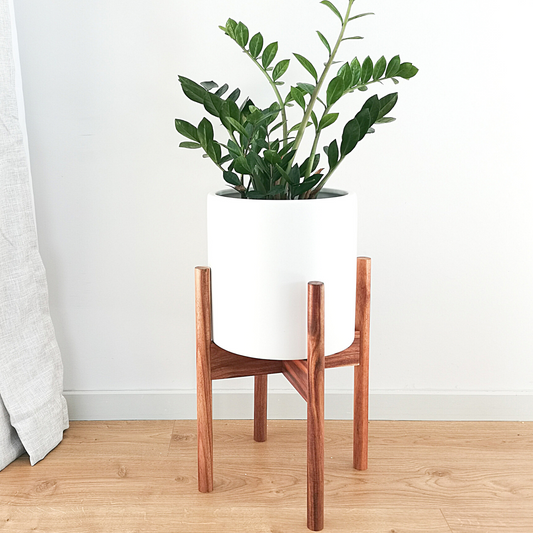Hello, fellow plant enthusiasts, today, we embark on an exciting journey to elevate your indoor oasis by uncovering a hidden gem that holds the power to transform your plant care routine: coffee grounds. Yes, you heard it right! Those aromatic remnants of your morning brew can do wonders for your leafy companions.

We'll explore why there's so much hype around using coffee grounds for plants, exploring their remarkable benefits and uncovering the secrets behind their green-thumb prowess. Prepare to witness your foliage flourish!
In our blog today, you'll find out how to incorporate coffee grounds into your plant care routine, ensuring you unlock their full potential. But that's not all! To further expand your horticultural horizons, we'll showcase some ingenious DIY projects and clever styling ideas, showcasing how coffee grounds can infuse an element of organic charm into your interior design scheme.
So, get ready to take notes as we embark on this journey through the lush landscapes of coffee grounds for plants and how this secret ingredient helps cultivate thriving, vibrant indoor gardens.
Let's dig in!
Plant-Powering Properties of Coffee Grounds
Nutritional Composition of Coffee Grounds
Coffee grounds are a treasure trove of essential nutrients that can work wonders for your plants. As you sip your morning brew, you may not realize that those leftover grounds contain a wealth of minerals like nitrogen, phosphorus, and potassium. Nitrogen promotes lush, green foliage growth, phosphorus aids in root development, and potassium strengthens overall plant health. By incorporating coffee grounds into your gardening routine, you're essentially providing your plants with a nutrient-packed feast.
Natural Slow-Release Fertilizer
One of the remarkable qualities of coffee grounds is their ability to act as a slow-release fertilizer, gradually providing nourishment. Unlike synthetic fertilizers that can result in sudden growth spurts followed by nutrient deficiencies, coffee grounds offer a steady supply of nutrients over an extended period. This slow-release mechanism ensures a balanced and sustainable growth for your beloved foliage. To take advantage of this natural fertilizer, you can mix coffee grounds into your potting soil or sprinkle them on the surface as a top dressing. As the coffee grounds break down, they release nutrients slowly, allowing your plants to absorb them at their own pace. This gradual nourishment promotes stronger root systems, healthier leaves, and overall resilience.
Harnessing the Acidic Nature
Certain plants thrive in acidic soil conditions, and coffee grounds can be a game-changer in maintaining the ideal pH balance. Azaleas, hydrangeas, and blueberries, for instance, flourish in acidic environments. Coffee grounds naturally possess a slightly acidic pH, making them an excellent companion for these acid-loving plants. The acidity helps unlock essential minerals in the soil, aiding in nutrient absorption and overall plant health. To utilize coffee grounds' acidity, consider using them as a mulch around your plants. The gradual decomposition of the coffee grounds will release acidity into the soil, ensuring a consistent pH level for optimal growth. Remember, moderation is key. While coffee grounds can benefit acid-loving plants, excessive use can lead to over-acidification, so it's best to monitor the soil pH and adjust accordingly.
Pest Deterrent
In addition to their nutritional benefits, coffee grounds also possess natural pest deterrent properties, making them a valuable tool in your plant care arsenal. Certain pests, such as slugs, snails, and ants, detest the scent and texture of coffee grounds. By creating a protective barrier around your plants, you can effectively keep these unwanted visitors at bay. To ward off pests, sprinkle a generous amount of coffee grounds around the base of your plants or create a perimeter line around your garden beds. Not only does this act as a physical deterrent, but the strong aroma of coffee can also mask the scents that attract pests, resulting in an eco-friendly alternative to chemical pesticides.
Incorporating Coffee Grounds into Your Plant Care Routine
Collecting and Storing Coffee Grounds
To fully harness the potential of coffee grounds for your plants, it's essential to collect and store them properly. Start by designating a container specifically for coffee grounds in your kitchen. After brewing your daily cup of joe, simply empty the used coffee grounds into the container instead of tossing them in the trash. This simple habit helps reduce waste while providing you with a valuable resource for your plants. To preserve the freshness of the coffee grounds, ensure proper storage. Consider keeping them in an airtight container in a cool, dry place. This prevents the grounds from becoming moldy or losing their potency.
Composting
Composting is an eco-friendly practice that benefits both the environment and your plants. Coffee grounds are an excellent addition to your compost pile, enhancing its nutritional value and promoting healthy soil. When adding coffee grounds to your compost, aim for a balanced mix of organic materials such as leaves, grass clippings, and kitchen scraps. As you layer the coffee grounds into your compost bin, remember to add other brown materials like dry leaves or shredded newspaper to maintain the right carbon-to-nitrogen ratio. This balance ensures proper decomposition and prevents your compost from becoming too acidic. Over time, the coffee grounds will break down and enrich your compost with essential nutrients, creating a nutrient-dense concoction that can be used to fertilize your plants naturally.
Brewing Coffee Grounds Tea
Did you know that you can brew a nutrient-packed tea using coffee grounds? This simple and cost-effective method allows you to extract the goodness of coffee grounds and provide your plants with a nourishing elixir. To make coffee grounds tea, start by steeping used coffee grounds in water for 24 to 48 hours. The water will absorb the nutrients from the grounds, creating a concentrated liquid fertilizer. Once the steeping process is complete, strain the liquid and dilute it with water to achieve the desired potency. You can then use this homemade coffee grounds tea to water your plants, delivering a boost of nutrients directly to their roots. This natural fertilizer is particularly beneficial for potted plants or those that require a quick nutrient boost.
Enhancing Nutrient Absorption and Soil Structure
Enhancing the Soil's Ability to Absorb and Retain Nutrients
Coffee grounds have a remarkable ability to enhance nutrient uptake in soil, ensuring that your plants receive the nourishment they need to thrive. When coffee grounds are incorporated into the soil, they improve its texture and structure, allowing for better water penetration and nutrient absorption. This is especially beneficial for compacted or nutrient-deficient soils. As coffee grounds break down, they release organic matter into the soil, which acts as a natural sponge, retaining moisture and nutrients. This creates an ideal environment for beneficial microorganisms to thrive, further aiding in nutrient cycling and availability.
Promoting Healthy Root Growth
Healthy root growth is essential for strong and resilient plants. Coffee grounds play a significant role in promoting robust root systems by improving soil structure. Their fine texture helps to break up compacted soil, allowing roots to penetrate easily and access essential nutrients and water. To take advantage of this benefit, consider adding coffee grounds to your planting holes when transplanting or repotting. The coffee grounds will work their magic, providing a loose and well-aerated soil environment that encourages root expansion. This is particularly beneficial for plants that require well-draining soil, such as succulents or herbs. Additionally, the increased porosity of the soil facilitates oxygen exchange, preventing root rot and promoting overall plant health.
Regulate Soil Moisture and Prevent Waterlogging
Proper moisture balance is crucial for plant health, as both waterlogging and excessive drying can be detrimental. Coffee grounds can help regulate soil moisture levels by acting as a moisture retainer. When added to the soil, they absorb excess water and slowly release it back into the root zone, preventing waterlogging and promoting a healthy moisture equilibrium. Mix the coffee grounds into the soil before planting or apply them as a top dressing around your plants. They will create a buffer, helping to maintain consistent soil moisture levels and preventing rapid water evaporation. This is especially beneficial for plants that require stable moisture, such as ferns or tropical houseplants.
Impact of Coffee Grounds on Soil Microbial Activity
A healthy soil ecosystem relies on a thriving community of beneficial microorganisms. Coffee grounds contribute to this intricate web of life by providing a nourishing environment for soil-dwelling microbes. As coffee grounds decompose, they become a food source for bacteria, fungi, and other beneficial organisms that aid in nutrient cycling and soil fertility. By incorporating them into your soil, you're creating an inviting habitat for these microorganisms to flourish. This, in turn, enhances soil health and promotes the breakdown of organic matter, making nutrients more readily available to your plants. A vibrant microbial community also helps suppress harmful pathogens, reducing the risk of plant diseases. With coffee grounds as an ally, your plants will not only receive direct nutrient benefits but also thrive in a harmonious soil ecosystem.
DIY Projects and Styling Tips to Infuse Coffee Grounds into Your Interior Design

- Terrariums - Add a sprinkle on the top of the soil to mimic moss, which will help to retain the moisture within the terrarium
- Potpurri - Mix coffee ground coffee, dried flowers, herbs and essential oils to create sachets you can place around the house
- Natural Dyes - Steep a strong brew of coffee and let cool. Immerse fabric or paper to create natural earthy tones.
Throughout our exploration, it has become evident that coffee grounds offer a multitude of benefits for our beloved plants. Providing essential nutrients, improving soil health, regulating moisture levels, deterring pests, and even offering creative opportunities for incorporating organic elegance into our design schemes.
So, as you take that next sip of your delicious home brew coffee, remember to keep them aside and within no time you'll be surrounded by luscious, healthy plants!










